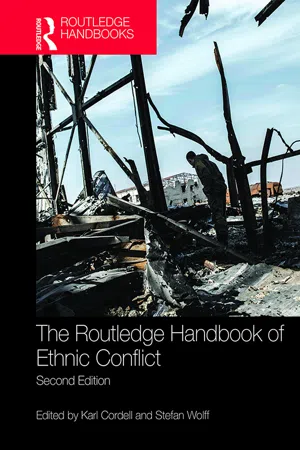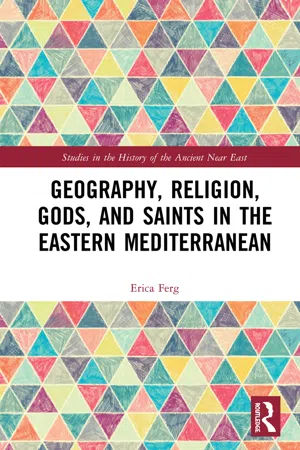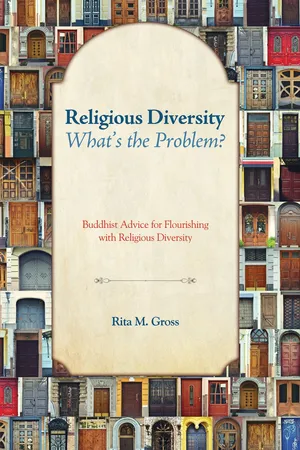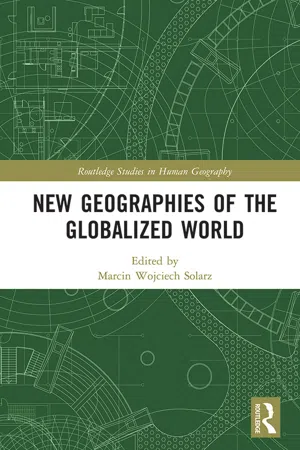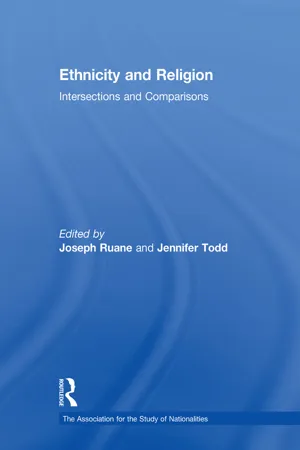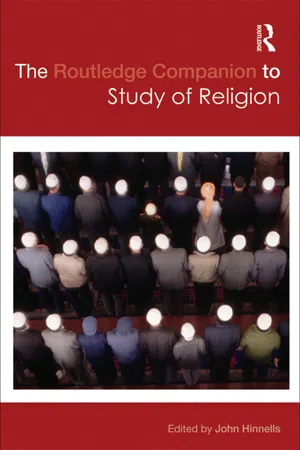Geography
Ethnic Religions
Ethnic religions are belief systems that are closely tied to a particular ethnic group or culture. They are often passed down through generations and are deeply ingrained in the traditions and customs of the community. These religions typically do not seek converts and are closely linked to the identity and heritage of the people who practice them.
Written by Perlego with AI-assistance
Related key terms
Related key terms
1 of 4
Related key terms
1 of 3
9 Key excerpts on "Ethnic Religions"
- eBook - ePub
- Karl Cordell, Stefan Wolff, Karl Cordell, Stefan Wolff, Karl Cordell, Stefan Wolff(Authors)
- 2016(Publication Date)
- Routledge(Publisher)
There are also many studies of the interrelation of ethnicity and religion in conflict situations (for example Kakar’s (1996) study of Hindu and Muslim rioters in Hyderabad). Such research raises important theoretical and explanatory questions. Where ethnicity and religion are intertwined, is religion simply a legitimatory resource for other interests? Or do religious beliefs themselves inform the framing of interests and assumptions about the world to a point where, in Walter Benjamin’s terms, religion is the puppet-master pulling the strings of seemingly secular groups (Benjamin 1969 : 253–255)? And how are religious and ethnic ideas and aims put to use in processes of mobilisation and intra-group contest? As we show below, attempts to answer these questions have required some reframing of concepts of ethnicity. Concepts of religion and ethnicity Classical scholarship on ethnicity and ethno-nationalism carefully distinguished religion from ethnicity. Anthony D. Smith defined ethnicity as involving each of the following six features: a common name; a myth of common ancestry; shared historical memories; elements of common culture; a link to a homeland; a sense of solidarity (Smith 1986 : 21–31). Definitions are contested in the wider literature, but there is some consensus that central to ethnicity is perceived territorially based descent, which in turn tends to generate quasi-kin feelings of solidarity (Conversi 2002). Religion may be defined substantively as beliefs and practices concerned with the sacred, with particular religions identified in terms of institutionally based and bounded sets of such beliefs and practices, and the religious (confessional) groups who participate in them. On Smith’s definition of ethnicity, religion may form the common culture that partially constitutes the ethnie, but ethnicity requires also a territorial and descent-related emphasis - Erica Ferg(Author)
- 2020(Publication Date)
- Routledge(Publisher)
23 These local studies of religion account for the intersections of time and place in analyses of specific religious traditions. That is, according to a Geography of Religion theoretical perspective, religions are inherently geographically contextualized: prevailing political, social, religious, and physical-geographical conditions evident within a particular locality are understood to influence the development and manifestation of that locality’s religious traditions at any given point in time.Returning to the case of third-century Syria, a World Religions approach might suggest that we understand the manifestation of Christianity as reflected in period-specific thinkers and texts. Within this approach, thinkers and texts often are contextualized, but those texts and thinkers tend also to be viewed tautologically, as signposts along the road of a comprehensive tradition whose final outcome already is known. Furthermore, analysis of a religious tradition within the World Religions theoretical framework, especially of that tradition in earlier time periods, has tended to be restricted to the analysis of foundational religious texts. The larger logical problem with the World Religions emphasis on texts is that often it is unjustifiably reasoned that if one understands the foundational texts of a tradition, one can thus claim to understand the tradition as a whole in all times and places, which simply is not the case.A Geography of Religion approach, on the other hand, suggests that in examining Christianity in third-century Syria, one should consider the prevailing third-century political, social, religious, and physical-geographical conditions which combined to influence the tradition. That is, in which ways did those influences combine to affect that manifestation of Christianity in that time and place? In which ways were this tradition’s customs, doctrines, and practices lived out- eBook - ePub
Christianity in Contemporary China
Socio-cultural Perspectives
- Francis Khek Gee Lim(Author)
- 2013(Publication Date)
- Routledge(Publisher)
Third, the ‘ethnic’ component of this religious community is further shaped by a shared sense of history and internal solidarity generated through common historical experience of interacting with other local non-Christian groups, the state, and transnational social actors. Fourth, the religio-ethnic group is often associated with a particular geographic area. This is partly due to the traditional settlement pattern of constituent members of the religio-ethnic group, and partly due to the state’s residential policy in terms of the hukou system that made it very difficult for rural Christians to migrate permanently to other areas. Finally, religious and geographical identities overlap with kinship such that being a Christian to large extent is an ascribed status. Of course, Christianity as ethno-religion and as religio-ethnicity are not mutually exclusive phenomena. In fact, the former could be an important foundation for the latter. Take for instance ‘Lisu Protestantism’: while Christianity’s indigenization can be considered an example of it becoming Lisu’s ethno-religion, in that it has become integral to Lisu ethnic consciousness, ‘Lisu Protestantism’ can also be a religio-ethnicity as an indigenized Lisu Christianity, using Lisu script and language, spread to neighbouring ethnic groups such as the Nu or the Dulong which are not averse to Lisu cultural influences. The phenomenon of religio-ethnicity thus underscores the limitation of how ethnicity is understood via the state’s minzu classification system, which has become the dominant frame with which many people view ethnicity in China - the statement ‘there are fifty-six “nationalities”/ethnic groups in China’ appears in countless scholarly and official documents - eBook - ePub
Religious Diversity—What's the Problem?
Buddhist Advice for Flourishing with Religious Diversity
- Gross(Author)
- 2014(Publication Date)
- Cascade Books(Publisher)
8 and that if we regard Buddhism as a single religion, we could also regard Judaism, Christianity, and Islam as different sects of an overarching monotheistic religion—a claim I find quite cogent. A religion that was once a universalizing religion can become an ethnoreligion due to historical circumstances and hardship, as happened to Judaism. A religion that has not become universalizing because it has not spread widely could become so in different circumstances. There is no reason why Confucian or Daoist ideas could not appeal widely. They have as much general relevance as Buddhist, Christian, or Muslim ideas, but they have not had the historical fortune to spread widely. Even a stereotypical ethnoreligion can have widespread appeal. Followers of indigenous Native American religions are very reluctant to open their practices to outsiders, but a few teachers do. As I watched blond Germans who traveled to South Dakota every year dance in the annual Sundance, I also watched the categories “ethnoreligion” and “universalizing religion” collapse before my eyes. Nevertheless, they are useful general categories.Among the world’s religions, we can isolate at least four distinct ways of negotiating religious diversity, four ways that individuals who belong to one of the religions are encouraged to think about the diversity of the world’s religions. In only one of them are believers encouraged to think that they alone possess religious truth and that the world would be a better place if everyone belonged to their religion.In ethnoreligious contexts and in some other situations, believers may erect barriers against outsiders rather than trying to lure them into religious participation. These adherents clearly do not believe that it is necessary for the salvation of outsiders that the outsiders begin to think and act like the insiders. As has already been noted, ethnoreligions are characterized by a close intertwining of religion and culture, which helps explain adherents’ attitudes toward religious others. To practice the religion, an outsider would have to join the culture completely, and there is little reason to promote or accept such conversion. While members of an ethnoreligion obviously prefer their own religion and culture to any other, they do not regard it as categorically superior in the same way that those who make exclusive truth claims proclaim superiority for their religionsEthnoreligions and some others present another interesting counter-example to the expectation that everyone should practice the same religion. Even within a single ethnoreligion, people may not know the details of one another’s religious experiences or the specifics of their beliefs and practices. This secrecy is simply accepted, and no one feels deprived because they are not privy to the religious practices of others. People feel that it is simply inappropriate to share one’s own religious experiences with anyone except one’s teacher or closest companions. Though as a Buddhist I belong to a universalizing religion, many aspects of my particular path as a practitioner of Tibetan Vajrayana Buddhism predispose me to be very sympathetic to this ethnoreligious approach. There is a great deal of secrecy in Vajrayana Buddhism. The view is that too much information too soon could be destructive rather than helpful because the path of spiritual development is long and complex. Profound secrets disclosed too soon are usually either dangerous or easily trivialized. For Vajrayana Buddhists, the preferred practice is to introduce basics to those who request such instruction and gradually introduce other aspects of the tradition when appropriate. - eBook - ePub
- Marcin Wojciech Solarz, Marcin Wojciech Solarz(Authors)
- 2018(Publication Date)
- Routledge(Publisher)
Ethnoreligionists make up 3.5 per cent of the world’s population (about 400 million adherents) according to WRD data. These are various groups which follow natural religion, and include animists, spirit-worshippers, shamanists, ancestor-venerators and polytheists, as well as local or tribal folk-religionists. Ethnic Religions are usually based on oral tradition, such as myths, rituals and rites passed down from generation to generation (Johnson and Grim 2013: 38). In these religions, the sacred sphere mixes with the profane and permeates the daily lives of believers, who rarely consider the spirit world as separate from the real world. Under the influence of missionary religions, especially Islam and Christianity, the number of followers of the traditional religions is falling, but often, through a merging of the boundaries between old and new, syncretic religions are formed which are difficult to classify unambiguously. In 1910, Ethnic Religions were practised by 58 per cent of Africans, 5.6 per cent of Asians, 0.2 per cent of Europeans, 3.5 per cent of South Americans, 0.2 per cent of North Americans and 19.7 per cent of Oceanians (including 83.3 per cent of Melanesians and 23.3 per cent of Micronesians, but interestingly only a small fraction of a per cent of Polynesians and 1.2 per cent of Australians and New Zealanders) (Johnson and Grim 2013: 39). In 2010, the figure for Africa had fallen to 8.7 per cent, in Asia it was 3.5 per cent, 0.2 per cent in Europe, 0.6 per cent in South America, 0.4 per cent in North American and 1 per cent in Oceania. The countries with the largest numbers of Ethnoreligionists today are: China (57.8 million, which is in addition to the number of Chinese Folk-Religionists), India (45.8 million) and Nigeria (12.1 million). Vietnam, Madagascar, South Korea, Mozambique, Indonesia, Tanzania and Ethiopia all have populations of between 5 and 10 million Ethnoreligionists (Johnson and Grim 2013: 39).The demography of religion includes the category of New Religionists. These are members of various Hindu or Buddhist sects, and also syncretic religions, which combine elements of Christianity and Eastern religions (Johnson and Grim 2013: 41). In 2010, the number of New Religionists amounted to 63 million or about 0.9 per cent of the world’s population, primarily in Asia (especially in Japan and Indonesia) and Latin America. The largest of the new religions in terms of the number of adherents is Soko Gakkai International (18.5 million adherents or 29.4 per cent of all New Religionists), which was founded in Japan in 1930 on the basis of Buddhism, and since 1975 has been an international movement (Johnson and Grim 2013: 45). - eBook - ePub
Ethnicity and Religion
Intersections and Comparisons
- Joseph Ruane, Jennifer Todd(Authors)
- 2014(Publication Date)
- Routledge(Publisher)
The Situational Importance of Ethnicity and Religion in Ghana ARNIM LANGER University of Oxford, UKABSTRACT Although ethnicity is an important identity marker in many countries, people have multiple identities relating to (among others things) ethnicity, religion, region of origin, occupation and gender. None of these identities exists in isolation and they are usually linked in intricate ways and sometimes overlap, partially or completely. This study investigates the hypothesis that religious and ethnic affiliations can be and are held concomitantly, but that the relative importance attached to a specific dimension cannot only vary between different groups but also fluctuate between different contexts. While religious identification may be ascriptively or prescriptively considered relatively more important in certain social settings, ethnic identification may take on prime importance in other contexts. This hypothesis is examined through an analysis of survey data of attitudes and perceptions towards identity in Ghana.Introduction
Although there is no commonly accepted definition, ethnicity is generally characterized as a sense of group belonging, based on ideas of common origins, history, culture, language, experience and values (see e.g. Glazer & Moynihan, 1976; Anderson, 1983; Horowitz, 1985; Varshney, 2001, Bates, 2004). Although ethnicity is an important identity marker in many countries, people have multiple identities relating to (among others things) ethnicity, religion, region of origin, occupation and gender. None of these identities exists in isolation and they are usually linked in intricate ways and sometimes overlap, partially or completely. As noted in the introduction of this volume, one question that has been largely ignored in the ethnicity literature is what happens when religious and ethnic identity boundaries overlap. Moreover, in cases where there is such an overlap, scholars of ethnicity are often at something of a loss over how to deal with religion and religious identification, in particular whether or not it simply constitutes another form of identity ‘marker’ akin to language, dress or other cultural practices. - eBook - ePub
Racism and Ethnic Inequality in a Time of Crisis
Findings from the Evidence for Equality National Survey
- Nissa Finney, James Nazroo, Laia Bécares, Dharmi Kapadia, Natalie Shlomo(Authors)
- 2023(Publication Date)
- Policy Press(Publisher)
Umaña-Taylor, 2011 ). For minority groups, participating in ethnicity- and/or religion-related practices might provide a safe space for people to interact with others, build a positive sense of self and foster a sense of belonging. Furthermore, religious institutions have long served as hubs of social and civic life as well as places offering practical advice and charitable activities. As noted by Nicholson (2018), for migrant communities, churches, mosques, gurdwaras, temples and synagogues play a particularly important role for connection and practical support in a new country.Ethnic and religious identities not only constitute building blocks of self-concept but are also used as social markers (Kapadia and Bradby, 2021 ), which affect how group boundaries are defined and used in a society. For example, in the UK, the ethnicity classifications have been introduced with the intention of better understanding and monitoring social inequalities among different social groups that share common origin/ancestry (Williams and Husk, 2013 ). However, it is important to acknowledge that such ethnicity categorisations are defined and to some extent imposed by the more powerful ‘majority’ on the less powerful ‘minority’ (Nazroo and Karlsen, 2003 ). This means that, in part, minority ethnic identities become constructed in response to externally defined ethnic groupings. The use of such categorisations can in turn marginalise certain ethnic minority groups.The process of categorisation makes groups more or less visible and situates them within debates on integration, social cohesion and British values. Every few years, the debates on the national identity crisis resurface, especially in the context of growing ethnic and religious diversity and immigration (Finney and Simpson, 2009 ). Feelings of belonging to the national community are generally believed to have many positive consequences, including greater social cohesion and a sense of solidarity. Focus on cohesion and solidarity has characterised government reports on diversity in recent years (see, for example, Casey Review, 2016 ). Such discussions led to the turn against policies of multiculturalism and the emphasis on shared national values as underpinning integration. This has resulted in policies such as more demanding citizenship tests and mandatory citizenship ceremonies, with the aim of ensuring the ‘successful integration’ of naturalised citizens. The ideology behind and the success of such practices have been contested (Byrne, 2017 ), but the appetite for practices that intend to facilitate a common sense of British identity and belonging have remained popular in political discourse. For example, since 2014, schools in the UK have been required to introduce the active promotion of British values into their curricula (Department for Education, 2014 - eBook - ePub
Sacred Worlds
An Introduction to Geography and Religion
- Chris Park(Author)
- 2002(Publication Date)
- Routledge(Publisher)
This theme has traditionally attracted much geographical attention, partly because of the discipline’s enduring interest in landscape as a product of natural and cultural processes. Some would agree with Erich Isaac that the theme of religion and landscape is not simply a component of the geography of religion, it is the very core of the subject. Indeed, Isaac defines the geography of religion as(Isaac 1960:14)the study of the part played by the religious motive in man’s transformation of the landscape. It presumes the existence of a religious impulse in man which leads him to act upon his environment in a manner which responds secondarily, if at all, to any other need.Landscape is a palimpsest, or a manuscript on which two or more successive texts have been written, each one being erased to make room for the next. Quite how much is erased varies from place to place, so that some landscapes preserve a great deal of evidence of their past whilst others are predominantly contemporary in appearance. This dynamic gives rise to the variable mosaic of landscape even within an area, and it provides opportunities for historic reconstruction based on visible landscape features. Jackson (1952:5) insists that ‘the cultural history of America is just as legible in the appearance of our landscape (for those who know how to read it) as it is in the monuments and institutions of our cities’, and this is equally true in all countries.Interpretation of landscape as a product of culture requires some understanding of how people translate values and beliefs into architectural forms, and how their values and beliefs inform their use of space, such as in the spatial organisation of settlements (Sitwell and Bilash 1986). Sitwell and Latham (1979) have called upon geographers to direct more effort to understanding the role in shaping landscape of explicit beliefs (expressed by what people say) and functional beliefs (expressed by how people behave). Sitwell explored the possibility of interpreting elements in the cultural landscape as being ‘concrete’ signifiers standing in place of verbal signifiers, using the metaphors of height, durability and central location. - eBook - ePub
- John Hinnells(Author)
- 2009(Publication Date)
- Routledge(Publisher)
Despite the evident salience of such processes of glocalisation, where religious and cultural identities are both deterritorialised and reterritorialised, in diaspora especially, many second-and third-generation youth are prioritising what they see as the universals of religion from the localised custom they associate with their parents’ and grandparents’ homelands. One way of analysing this situation is to relate it to Mol’s (1979) conception of religion as the ‘sacralizer of identity’ and ‘harnesser of change’. Because religion, backed by the sacred authority of the past, has such great potential for articulating distinctiveness in its own right, this can open the way for other potential markers of ethnic identity to become more negotiable as time passes and those born in the diaspora establish their own priorities and ‘routes’. So long as religious boundaries are maintained – and, recalling Cohen (1985), this does not require unchanging content – language and aspects of custom, as well as attachment to the homeland per se, can become relatively less important and perhaps eventually abandoned altogether. This opens up the possibility for a new, more mobile, religious ‘homing desire’ (Brah 1996:179–80) without the risk of losing all sense of continuity in a ‘chain of memory’ (cf. Hervieu-Léger 2000). Indeed, the prioritisation of religion over custom, especially for those with most invested in new contexts, can facilitate adaptation and acculturation, while all the time retaining a sense of pride in distinctiveness and rejecting outright assimilation. Ter Haar (1998), for example, shows how many African Christians in Europe are forward, rather than backward, looking. They see themselves as part of an international, rather than an ethnic, church, deliberately using religion as a source of capital to bridge outwards and link upwards beyond the bonding provided by cultural heritage per se.In a roundabout way then, Cohen’s account of religion does actually begin to strike the right chord. On the one hand, religions can and do provide ‘additional cement’ and ‘cohesion’ to ‘territorial’ ethno-national diasporas (1997:189; 2008:153). However, in different contexts, the very same traditions, differently configured and deployed, can challenge and transcend ethnicity (as well as the nation-state – see Baumann 1999) by forging multi-ethnic and more universalising networks and linkages. They can point beyond the territorial to the extraterritorial (1997:189), whether that be in terms of the convergences of a global ethics and civil society or the conflicts of transnational terrorism (Jurgensmeyer 2002). In our penultimate section I briefly summarise how religious studies’ more empirical agenda, in terms of mapping contemporary patterns and trends, has evolved in the last decade or so.Mapping religion and diaspora: summary patterns and trends
Perhaps the main characteristic of contemporary scholarship on religion and diaspora has been the growth of empirical studies. In many ways this is more representative of the research that has been completed than the theoretical debates considered in the previous section. To give a flavour of this work, and provide an opportunity for further reading, indicative studies of contemporary Sikhs, Christians, Jews, Hindus, Zoroastrians, Buddhists, Muslims and others have all been cited in endnotes to this chapter. The majority focus on people resettled in North America and Europe, although the processes described are by no means confined to the West and increasingly reflect cross-border circulations. With just a few exceptions, all were written in the 1990s or 2000s. This reflects the fact that, in the last two decades or so, diasporas established in the post-war period have begun to mature and are increasingly visible in public life (Coward et al.
Index pages curate the most relevant extracts from our library of academic textbooks. They’ve been created using an in-house natural language model (NLM), each adding context and meaning to key research topics.
Explore more topic indexes
Explore more topic indexes
1 of 6
Explore more topic indexes
1 of 4
